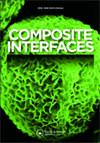通过超分子自组装和挤出,层次化(1D, 2D和3D)碳基纳米填料在热塑性聚氨酯中的大规模分散
IF 2.4
4区 材料科学
Q3 MATERIALS SCIENCE, COMPOSITES
引用次数: 0
摘要
摘要采用双螺杆挤出(TSE)的方法,将羧化多壁碳纳米管(MWCNT-COOH为1D)、羟基化少层石墨烯(FLG-OH为2D)和固定化多壁碳纳米管(MWCNT-COOH为3D)等层次化碳纳米填料分散到分段热塑性聚氨酯(TPU)中。纳米填料的浓度分别为0.25、0.5、1.0、2.0和5 wt%。为了提高分散水平,还通过超分子自组装路线(SSAR)产生细胞结构,将混合3D纳米填料掺入TPU中。发现纳米填料均匀分散的细胞结构,然后用TSE技术复合。与直接TSE相比,在较高的负载(2 wt%)下,SSAR + TSE观察到大规模均匀分散。直接TSE法在1 wt%的负载下发现均匀分散。以2 wt%的杂化三维纳米填料增强的PU纳米复合膜具有良好的气体阻隔性能,其氦气渗透率从纯PU膜的1287 cm3/m2/天降低至472 cm3/m2/天,降低了约63%。作者感谢国防研究与发展组织DMSRDE主任的支持、鼓励和允许发表本文。作者非常感谢Bapan Adak博士(前博士学者,印度理工学院德里分校)帮助通过TSE制备样品和通过压缩成型制备薄膜;来自坎普尔(DRDO) DMSRDE的Uttam Saha先生(负责ATR-FTIR)、Sanjay Kanojia先生(负责TGA)、Abhisar Hudda先生、Shudhanshu Singh先生(负责XRD)和Ratna Singh女士(帮助准备手稿)。作者对Vipul Garg先生(印度理工学院理工学院学生)在低温超微组方面的帮助表示感谢。作者还感谢阿格拉ADRDE (DRDO)为氦气渗透率测试提供了设备。作者非常感谢印度理工学院德里的中央研究中心(CRF)(提供TEM设备)和印度理工学院坎普尔的纳米研究中心(NRC)(提供FE-SEM设备)。作者感谢DMSRDE, DRDO, Kanpur主任的帮助,财政支持,并允许发表他们的实验结果。披露声明作者未报告潜在的利益冲突。本文的补充数据可以在线访问https://doi.org/10.1080/09276440.2023.2269344本文章由计算机程序翻译,如有差异,请以英文原文为准。
Large-scale dispersion of the hierarchical (1D, 2D and 3D) carbonaceous nanofillers in thermoplastic polyurethane through supramolecular self-assembly and extrusion
ABSTRACTThe hierarchical carbonaceous nanofillers viz. carboxylated multiwalled carbon nanotube (MWCNT-COOH as 1D), hydroxylated few-layer graphene (FLG-OH as 2D), and hybrid 3D i.e., MWCNT-COOH immobilized into FLG-OH were dispersed into segmented thermoplastic polyurethane (TPU) by twin-screw extrusion (TSE). The concentration of nanofillers was varied as 0.25, 0.5, 1.0, 2.0 and 5 wt%. To increase the level of dispersion, hybrid 3D nanofillers were also incorporated into TPU by producing cellular structures through supramolecular self-assembly route (SSAR). The cellular structure in which the nanofillers were found to be uniformly dispersed was then compounded by TSE technique. The large-scale uniform dispersion was observed at higher loading (2 wt%) by SSAR followed by TSE when compared with direct TSE. Uniform dispersion was found at 1 wt% loading by direct TSE. PU nanocomposite film reinforced with 2 wt% hybrid 3D nanofillers showed good gas barrier property with ~63% reduction of helium gas permeability to 472 cm3/m2/day from 1287 cm3/m2/day of neat PU film.KEYWORDS: Polyurethanecarbonaceous nanofillersextrusionsupramolecular self-assemblydispersion AcknowledgementsThe authors are thankful to the Director, DMSRDE, Defence Research and Development Organization for support, encouragement, and giving permission to publish the article. The authors are very grateful to Dr. Bapan Adak (former PhD Scholar, IIT Delhi) for helping to prepare the samples by TSE and film preparation by compression molding; Mr. Uttam Saha (for ATR-FTIR), Mr. Sanjay Kanojia (for TGA), Mr. Abhisar Hudda, Mr. Shudhanshu Singh (for XRD), and Ms. Ratna Singh (for helping to prepare the manuscript) from DMSRDE, Kanpur (DRDO). The authors extend their gratitude to Mr. Vipul Garg (B.Tech student, IIT Delhi) for his help with cryo-ultramicrotome. The authors are also thankful to ADRDE, Agra (DRDO), for providing the facility for helium gas permeability testing. The authors are very thankful to the Central Research Facility (CRF), IIT Delhi, India (for providing TEM facility), and the Nano Research Centre (NRC), IIT Kanpur, India (for providing FE-SEM facility). The authors are grateful to the Director, DMSRDE, DRDO, Kanpur, for help, financial support, and granting permission to publish their experimental findings.Disclosure statementNo potential conflict of interest was reported by the author(s).Supplementary dataSupplemental data for this article can be accessed online at https://doi.org/10.1080/09276440.2023.2269344
求助全文
通过发布文献求助,成功后即可免费获取论文全文。
去求助
来源期刊

Composite Interfaces
工程技术-材料科学:复合
CiteScore
5.00
自引率
3.80%
发文量
58
审稿时长
3 months
期刊介绍:
Composite Interfaces publishes interdisciplinary scientific and engineering research articles on composite interfaces/interphases and their related phenomena. Presenting new concepts for the fundamental understanding of composite interface study, the journal balances interest in chemistry, physical properties, mechanical properties, molecular structures, characterization techniques and theories.
Composite Interfaces covers a wide range of topics including - but not restricted to:
-surface treatment of reinforcing fibers and fillers-
effect of interface structure on mechanical properties, physical properties, curing and rheology-
coupling agents-
synthesis of matrices designed to promote adhesion-
molecular and atomic characterization of interfaces-
interfacial morphology-
dynamic mechanical study of interphases-
interfacial compatibilization-
adsorption-
tribology-
composites with organic, inorganic and metallic materials-
composites applied to aerospace, automotive, appliances, electronics, construction, marine, optical and biomedical fields
 求助内容:
求助内容: 应助结果提醒方式:
应助结果提醒方式:


